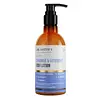What's inside
What's inside
 Key Ingredients
Key Ingredients

 Benefits
Benefits

 Concerns
Concerns

 Ingredients Side-by-side
Ingredients Side-by-side

Water
Skin ConditioningEthyl Olivate
EmollientOlive Oil Ethylhexyl Esters
Glycerin
HumectantParaffinum Liquidum
EmollientStearic Acid
CleansingGlyceryl Stearate
EmollientXylitylglucoside
HumectantAnhydroxylitol
HumectantXylitol
HumectantSodium Ascorbyl Phosphate
AntioxidantCetearyl Alcohol
EmollientAloe Barbadensis Leaf Extract
EmollientCocos Nucifera Oil
MaskingDimethicone
EmollientIsopropyl Myristate
EmollientOlea Europaea Fruit Oil
MaskingPolysorbate 80
EmulsifyingCetyl Palmitate
EmollientSodium Acrylate/Sodium Acryloyldimethyl Taurate Copolymer
Emulsion StabilisingHydrogenated Polydecene
EmollientTrideceth-6
EmulsifyingSorbitan Laurate
EmulsifyingCeramide AP
Skin ConditioningPhenoxyethanol
PreservativeCarbomer
Emulsion StabilisingSodium Benzoate
MaskingTocopheryl Acetate
AntioxidantSodium Hydroxide
BufferingPotassium Sorbate
PreservativeDisodium EDTA
BHT
AntioxidantPhyllanthus Emblica Fruit Extract
HumectantWater, Ethyl Olivate, Olive Oil Ethylhexyl Esters, Glycerin, Paraffinum Liquidum, Stearic Acid, Glyceryl Stearate, Xylitylglucoside, Anhydroxylitol, Xylitol, Sodium Ascorbyl Phosphate, Cetearyl Alcohol, Aloe Barbadensis Leaf Extract, Cocos Nucifera Oil, Dimethicone, Isopropyl Myristate, Olea Europaea Fruit Oil, Polysorbate 80, Cetyl Palmitate, Sodium Acrylate/Sodium Acryloyldimethyl Taurate Copolymer, Hydrogenated Polydecene, Trideceth-6, Sorbitan Laurate, Ceramide AP, Phenoxyethanol, Carbomer, Sodium Benzoate, Tocopheryl Acetate, Sodium Hydroxide, Potassium Sorbate, Disodium EDTA, BHT, Phyllanthus Emblica Fruit Extract
Water
Skin ConditioningLactic Acid
BufferingEthyl Olivate
EmollientOlive Oil Ethylhexyl Esters
Propylene Glycol
HumectantParaffinum Liquidum
EmollientGlyceryl Stearate
EmollientPEG-100 Stearate
Dimethicone
EmollientGlycerin
HumectantCetyl Alcohol
EmollientSalicylic Acid
MaskingRh-Rice Extract
Skin ConditioningImidazolidinyl Urea
PreservativeXanthan Gum
EmulsifyingMilk Protein
Skin ConditioningChamomilla Vulgaris Extract
Skin ProtectingMelaleuca Alternifolia Leaf Oil
AntioxidantWater, Lactic Acid, Ethyl Olivate, Olive Oil Ethylhexyl Esters, Propylene Glycol, Paraffinum Liquidum, Glyceryl Stearate, PEG-100 Stearate, Dimethicone, Glycerin, Cetyl Alcohol, Salicylic Acid, Rh-Rice Extract, Imidazolidinyl Urea, Xanthan Gum, Milk Protein, Chamomilla Vulgaris Extract, Melaleuca Alternifolia Leaf Oil
Ingredients Explained
These ingredients are found in both products.
Ingredients higher up in an ingredient list are typically present in a larger amount.
Dimethicone is a type of synthetic silicone created from natural materials such as quartz.
What it does:
Dimethicone comes in different viscosities:
Depending on the viscosity, dimethicone has different properties.
Ingredients lists don't always show which type is used, so we recommend reaching out to the brand if you have questions about the viscosity.
This ingredient is unlikely to cause irritation because it does not get absorbed into skin. However, people with silicone allergies should be careful about using this ingredient.
Note: Dimethicone may contribute to pilling. This is because it is not oil or water soluble, so pilling may occur when layered with products. When mixed with heavy oils in a formula, the outcome is also quite greasy.
Learn more about DimethiconeEthyl Olivate isn't fungal acne safe.
Glycerin is already naturally found in your skin. It helps moisturize and protect your skin.
A study from 2016 found glycerin to be more effective as a humectant than AHAs and hyaluronic acid.
As a humectant, it helps the skin stay hydrated by pulling moisture to your skin. The low molecular weight of glycerin allows it to pull moisture into the deeper layers of your skin.
Hydrated skin improves your skin barrier; Your skin barrier helps protect against irritants and bacteria.
Glycerin has also been found to have antimicrobial and antiviral properties. Due to these properties, glycerin is often used in wound and burn treatments.
In cosmetics, glycerin is usually derived from plants such as soybean or palm. However, it can also be sourced from animals, such as tallow or animal fat.
This ingredient is organic, colorless, odorless, and non-toxic.
Glycerin is the name for this ingredient in American English. British English uses Glycerol/Glycerine.
Learn more about GlycerinGlyceryl Stearate is a mix of glycerin and stearic acid.
It is used to stabilize the mixing of water and oil ingredients. By preventing these ingredients from separating, it can help elongate shelf life. It can also help thicken the product's texture.
As an emollient, it helps soften skin and supports barrier-replenishing ingredients.
In cosmetics, Glyceryl Stearate is often made from vegetable oils or synthetically produced.
This ingredient may not be fungal-acne safe
Fun fact: The human body also creates Glyceryl Stearate naturally.
Learn more about Glyceryl StearateOlive Oil Ethylhexyl Esters is an oil.
Paraffinum Liquidum is also known as liquid paraffin. It is a type of highly refined mineral oil.
Like other oils, Paraffinum Liquidum has emollient properties. Emollients help soothe and soften the skin. By creating a barrier to trap moisture within, emollients help keep your skin hydrated.
Paraffinum Liquidum does not irritate the skin and is non-comedogenic.
Learn more about Paraffinum LiquidumWater. It's the most common cosmetic ingredient of all. You'll usually see it at the top of ingredient lists, meaning that it makes up the largest part of the product.
So why is it so popular? Water most often acts as a solvent - this means that it helps dissolve other ingredients into the formulation.
You'll also recognize water as that liquid we all need to stay alive. If you see this, drink a glass of water. Stay hydrated!
Learn more about Water